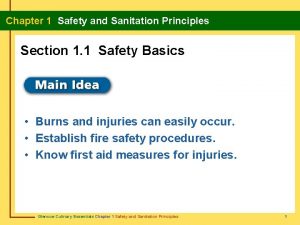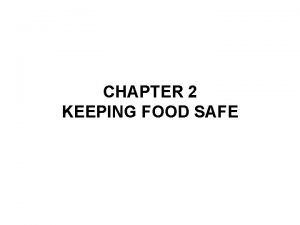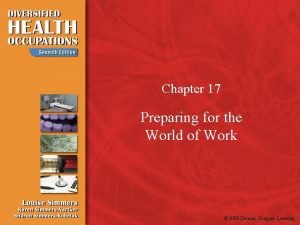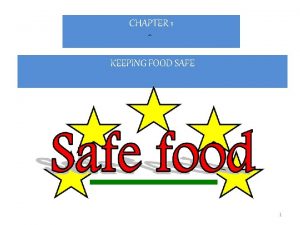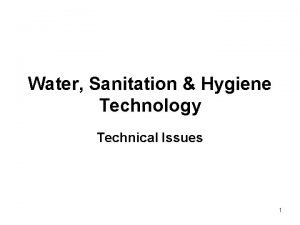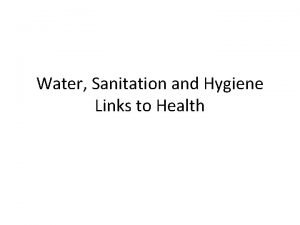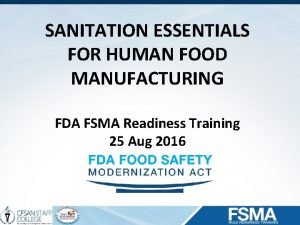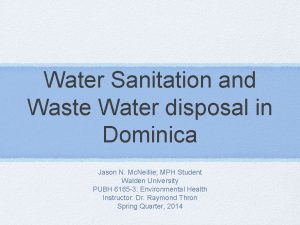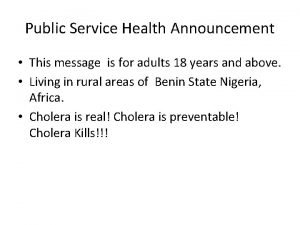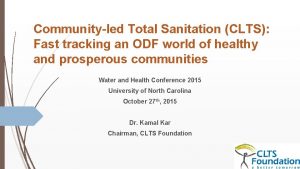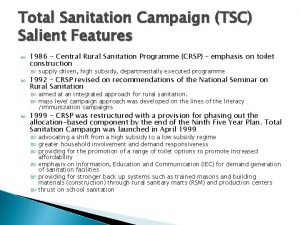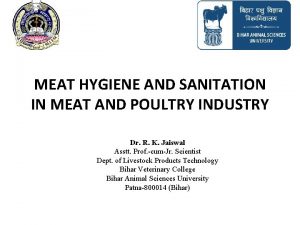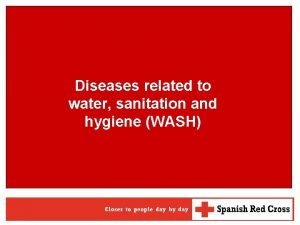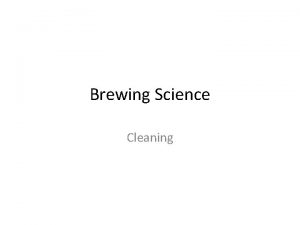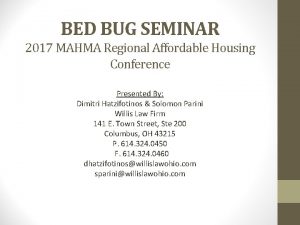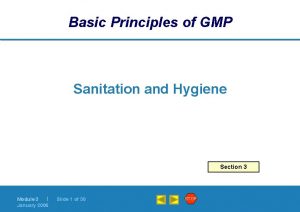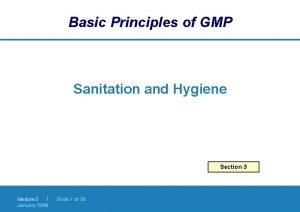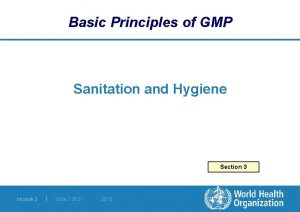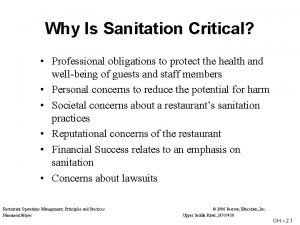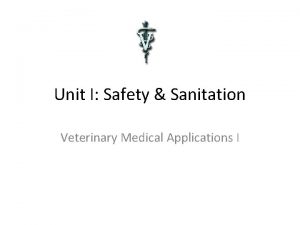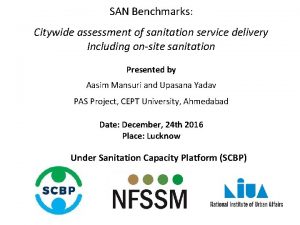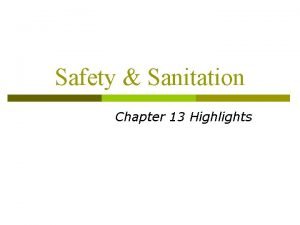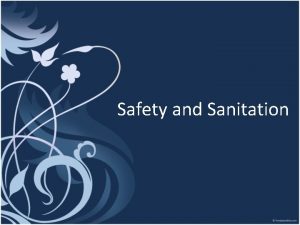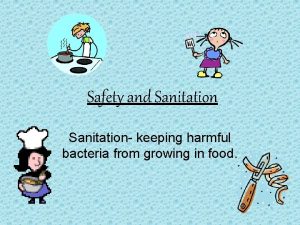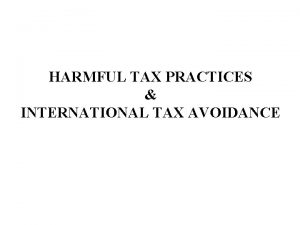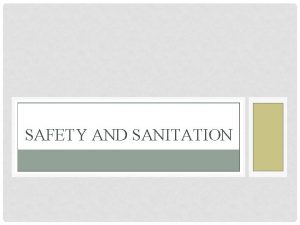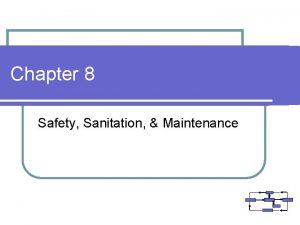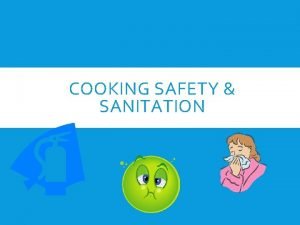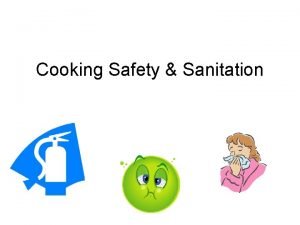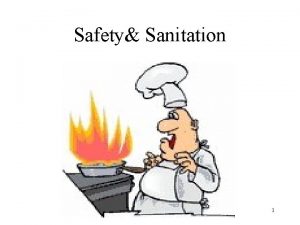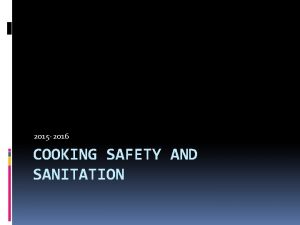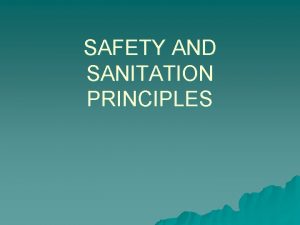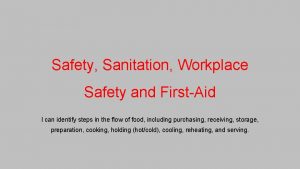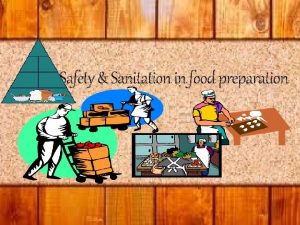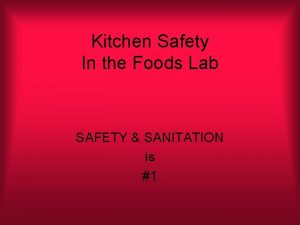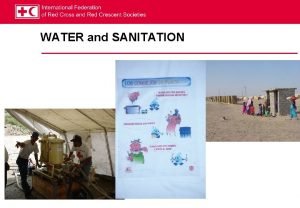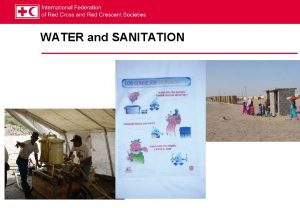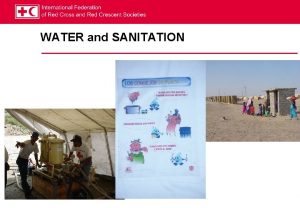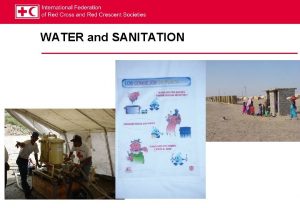Safety Sanitation Chapter 44 1 Sanitation Keeping harmful






































- Slides: 38

Safety & Sanitation Chapter 44 1

Sanitation ¢ Keeping harmful bacteria from growing in food ¢ Keep appliances, tools and yourself clean 2

¢ 3 Sanitation rules are important when you are preparing food with a group, such as a food lab

Kitchen Safety Pay attention to your work ¢ Develop careful work habits ¢ Follow safety rules consistently ¢ 4

Sources of Danger Knives and open cans are sharp ¢ Oven or range gets hop ¢ ¢ Less obvious are spills on the floor ¢ Cleaning products stored away from food and toddlers 5

Safety Precautions ¢ To prevent cuts: Always hold knife by its handle ¢ Cut away from you ¢ Wash knives separately ¢ Insert beaters into mixer before plugging it in ¢ Watch out for sharp edges on lids etc ¢ 6

To Prevent Burns & Scalding ¢ Use plastic handled spoon to stir hot foods ¢ Use pot holders ¢ Keep pan handles turned in over stove ¢ Lift the far side of a pan’s cover first so it won’t burn you 7

To Prevent Fires: Keep paper, dish towels, cleaning cloths off range ¢ Keep your sleeves away from flames ¢ Clean all grease off oven and range ¢ Smother grease fire by turning off heat and covering NEVER USE WATER ¢ Keep a fire extinguisher handy ¢ 8

To Prevent Electric Shocks Plus only one electric appliance into an outlet at a time ¢ Unplug appliances when they are not in use ¢ Don’t use appliances with frayed cords and don’t drape cords ¢ Keep electric appliances away from water ¢ Don’t stick metal objects into toaster ¢ 9

To Prevent other kinds of Injuries: Wipe up spills immediately ¢ Never leave anything on the floor ¢ Stand on a ladder or stool not a chair ¢ Turn all range controls to “Off” ¢ Never turn on gas range if you smell gas ¢ Store dangerous chemicals out of the reach of children ¢ 10

Kitchen Sanitation ¢ What is food-borne illness? ¢ An illness caused by eating food that is contaminated with harmful bacteria 11

Salmonella ¢ Bacterium that grows in foods such as poultry and eggs Spread from one food to another by improper cleaning cooking utensils and cutting boards ¢ Nausea, diarrhea, mild to severe cramps, and fever ¢ 12

Botulism More serious ¢ Can be fatal ¢ Affects nervous system ¢ Improperly canned foods ¢ Difficulty breathing, trouble swallowing and double vision ¢ Never taste or eat food from leaking or bulging cans or cracked, unsealed jars ¢ 13

Sanitation Practices ¢ Use hot, soapy water to wash tools, utensils, cutting boards ¢ Pay special attention when items come into contact with raw meat, poultry or eggs 14

¢ Wash your hands well before working with food and after using restroom ¢ Wash fresh fruits and veggies under cold, running water, wash tops of cans before opening 15

¢ Use a clean plate for cooked food ¢ Use only clean dishcloths, sponges, and towels ¢ Keep pets out of food prep area 16

¢ Use separate towels for wiping dishes and drying your hands ¢ Use a tissue when sneezing or coughing ¢ Keep hair tied back 17

¢ Use a separate spoon for tasting ¢ Avoid touching eating surfaces of plates, flatware, and glassware 18

Dealing with Pests ¢ Flies, ants, cockroaches, mice and rate contaminate foods Insecticides available ¢ Sprays and traps ¢ 19

Proper Temperatures ¢ Danger zone—range of temperatures between 60 degrees and 125 ¢ Two hour limit 20

Heating Foods High temps can kill most harmful bacteria ¢ Cooking time and temp will vary on most foods ¢ ¢ 21 Most internal temps should be 170 degrees

Other Bacterium ¢ Trichinosis—small worms in pork that will survive under 170 degrees ¢ E. coli – danger illness from eating contaminated, rare beef ¢ Poultry stuffing done outside of bird 22

¢ Hot foods hot ¢ Cold foods cols 23

Cooling Foods ¢ Low temperatures slow down, don’t stop growth of bacteria ¢ Take care with foods that spoil quickly Milk and meat l Egg rich food l ¢ 24 Freezing does not kill bacteria but keeps it from growing

FYI ¢ Other bacteria of concern to cooks include staphylococcus and E. coli. ¢ Staph live on human skin in the mouth and throat ¢ Spread by coughing, sneezing and touch with unclean hands, can cause nausea, vomiting and diarrhea 25

¢ E. coli may contaminate water, raw ground beef, and unpasteurized milk ¢ Produce toxins that can cause cramps, bloody diarrhea, and vomiting, ¢ Basic sanitation can prevent spread of both of these bacteria 26

botulism 27

¢ ¢ The classic symptoms of botulism include double vision, blurred vision, drooping eyelids, slurred speech, difficulty swallowing, dry mouth, and muscle weakness. Infants with botulism appear lethargic, feed poorly, are constipated, and have a weak cry and poor muscle tone. These are all symptoms of the muscle paralysis caused by the bacterial toxin. If untreated, these symptoms may progress to cause paralysis of the arms, legs, trunk and respiratory muscles. In foodborne botulism, symptoms generally begin 18 to 36 hours after eating a contaminated food, but they can occur as early as 6 hours or as late as 10 days. 28

E. coli 29

E. Coli Symptoms ¢ ¢ 30 Bloody diarrhea and stomach pain are the most common signs of E. coli O 157: H 7 sickness. People usually do not have a fever, or may have only a slight fever. Some people, especially children under 5 and the elderly, can become very sick from E. coli O 157: H 7. The infection damages their red blood cells and their kidneys. This only happens to about 1 out of 50 people, but it is very serious. Without hospital care, they can die. See a doctor right away if you think you may have gotten sick from E. coli O 157: H 7.

Trichinosis There approximately 40 cases per year in the US. ¢ Risk factors include eating meat from wild game. ¢ 31

Trichinosis in Eyes 32

What to do if you suspect foodborne illness: ¢ ¢ 33 1. Preserve the evidence. If a portion of the suspect food is available, wrap it securely, mark "DANGER, " and freeze it. Save all the packaging materials, such as cans or cartons. Write down the food type, the date, other identifying marks on the package, the time consumed, and when the onset of symptoms occurred. Save any identical unopened products. 2. Seek treatment as necessary. If the victim is in an "at risk" group, seek medical care immediately. Likewise, if symptoms (see chart next page) persist or are severe (such as bloody diarrhea, excessive nausea and vomiting, or high temperature), call your doctor.

3. Call the local health department if the suspect food was served at a large gathering, from a restaurant or other foodservice facility, or if it is a commercial product. ¢ 4. Call the USDA Meat and Poultry Hotline if the suspect food is a USDAinspected product and you have all the packaging. ¢ 34

Families were videotaped and the following were found: ¢ One woman handled raw chicken and then fixed a baby's bottle without washing her hands. ¢ Dozens of people dried their hands with the same dish towel they used to clean up raw meat juices. 35

¢ One person dropped a baby's bottle in raw eggs and neglected to use soap when they rinsed the bottle off. ¢ Only 45% of the people washed their hands before working in the kitchen and 16% of those who washed didn't use soap. 36

30% did not wash the lettuce they used, and some placed salad ingredients in raw-meat- contaminated containers. ¢ 25% of the people didn't know how to tell if chicken was cooked to a safe internal temperature, so they undercooked it. ¢ 37

38
 Useful materials harmful materials
Useful materials harmful materials Chapter 1 safety and sanitation principles
Chapter 1 safety and sanitation principles Chapter 8 sanitation procedures
Chapter 8 sanitation procedures Chapter 2 keeping food safe
Chapter 2 keeping food safe Chapter 17:1 developing job-keeping skills
Chapter 17:1 developing job-keeping skills Chapter 11 keeping a healthy weight study guide answers
Chapter 11 keeping a healthy weight study guide answers Keeping food safe chapter 1
Keeping food safe chapter 1 Sanitation and hygiene
Sanitation and hygiene Sanitation and hygiene
Sanitation and hygiene Concept school
Concept school Delvic sanitation initiatives
Delvic sanitation initiatives 7 steps of wet sanitation
7 steps of wet sanitation Environmental sanitation clearance
Environmental sanitation clearance Sanitation importance
Sanitation importance National shellfish sanitation program
National shellfish sanitation program Dominica economy
Dominica economy Conclusion on sanitation
Conclusion on sanitation Conclusion for hygiene
Conclusion for hygiene Anwser
Anwser Sanitation system definition
Sanitation system definition Conclusion on sanitation
Conclusion on sanitation Sanitation barrier psm
Sanitation barrier psm Central rural sanitation programme 1986
Central rural sanitation programme 1986 Drawing of sanitation
Drawing of sanitation Stakeholders in water and sanitation
Stakeholders in water and sanitation Poultry hygiene and sanitation
Poultry hygiene and sanitation Sanitation and hygiene
Sanitation and hygiene Cleaning and sanitation manual for breweries
Cleaning and sanitation manual for breweries Sanitation items
Sanitation items Gmp sanitation and hygiene
Gmp sanitation and hygiene Gmp sanitation and hygiene
Gmp sanitation and hygiene Gmp sanitation and hygiene
Gmp sanitation and hygiene Why is sanitation important
Why is sanitation important Why is sanitation important
Why is sanitation important Why is sanitation important
Why is sanitation important Types of sanitation
Types of sanitation On-site sanitation
On-site sanitation Why is sanitation important
Why is sanitation important Ministry of sanitation
Ministry of sanitation

